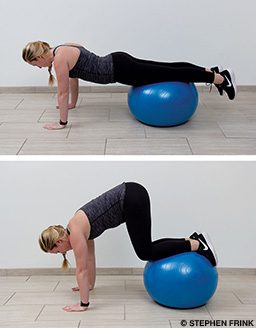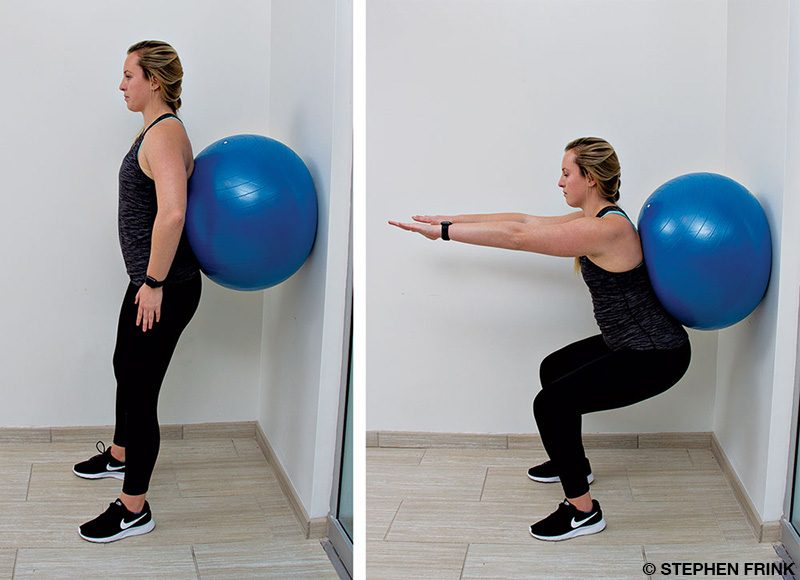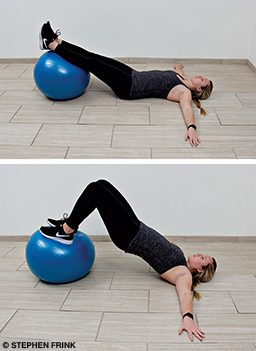It is important to optimize safety while diving by preparing your body for unexpected movements. The added weight of scuba gear raises your center of gravity, making your body less stable. That is why a small roll of a boat or an uneven step can have a larger than usual impact when you’re standing in full gear.
Physioball exercises will help develop strong stabilizing muscles, which are beneficial for maneuvering in water and on a rocking boat. The exercises prime these muscles to act quickly and effectively if you need to catch your balance, thereby protecting the integrity of your joints. There is no ground-reaction force in the aquatic environment, so your core musculature generates your propulsion.
Complete three circuits of eight repetitions of each of the following exercises. The physioball provides an unstable surface, so the movements may feel shaky at first. Move slowly, and focus on proper form as your nerves learn to activate the correct muscle fibers. Gradually increase repetitions of each circuit until you get to 12 repetitions of each exercise.
Knee Tuck (Abs)

- Start in a push-up position with your shoulders stacked over your hands, keeping the ball below your knees.
- Keep your legs parallel to ensure stability.
- Concentrate on contracting your abdominal muscles.
- Flex the hips and knees to bring your knees toward your chest.
- Extend your legs back to the starting position.
Tip: Maintain a strong body throughout the motion. If your body starts to sag, stop and regroup before continuing.
Modification: Start with the ball closer to your waist for less distance to travel.
Challenge: Go into pike position, keeping your legs straight.
Hip Bridge (Hips and Abs)

- Begin by lying on your back with your knees bent and heels resting on the ball.
- Your arms, hands, shoulders and head should stay in contact with the floor to ensure stabilization.
- Raise your hips while maintaining upper body contact with the floor.
- Lower to the starting position in a controlled manner.
Tip: Do not put weight on your neck.
Modification: Lift your hips as high as you feel comfortable. Listen to your body.
Challenge: Try to hold the position for a few seconds while squeezing your glutes. Make sure your knees stay close together.
Back Extension (Lower Back)
Strengthening the lower back reduces the risk of lower-back pain and stabilizes your spine.

- Begin by lying face down, extending your arms and supporting your hips with the ball. Extend your legs while maintaining foot contact with the floor.
- Extend your back, and raise your upper body off the ball.
Tip: Maintain a neutral spine with your arms extended in a straight line. Overextending the lower back can compress your intervertebral disc.
Modifications: Anchor your feet or have your feet touch a wall if you have difficulty keeping your body still. Start with the ball closer to your chest.
Challenge: Move the ball toward your hips, and try holding an extension for two to five seconds before releasing back down.
Wall Squat (Quads and Glutes)
- Start in a standing position with the ball supporting your lower back against the wall. Your feet may be further out than you expect.
- Flex your hips and knees to 90 degrees, and lower your supported upper body toward the floor.
- Maintain a neutral spine while keeping the knees in line with and behind the toes.
- Stand up and return to the starting position while maintaining core stability and balance.

Tip: Lean back into the ball as you descend and ascend.
Modification: Everyone’s range of motion (ROM) is different, so squat to only 45 degrees until you are comfortable with the movement.
Challenges: Hold the squat position for three to 10 seconds. Add a dumbbell.
Leg Curl (Hamstrings and Glutes)

- Start by lying with your legs fully extended, placing the ball under your calves.
- Ensure your upper body maintains contact with the floor.
- Flex your knees, and lift your hips to move your glutes, rolling the ball closer to you.
- After fully extending your hips, slowly return to the starting position.
Tips: Maintain a strong core. If your glutes start to sag, stop and regroup before continuing.
Modification: Start with a limited ROM (move the ball only a little bit with your feet).
Challenge: Hold the curled position for three to 10 seconds.
© Alert Diver — Q1 2020